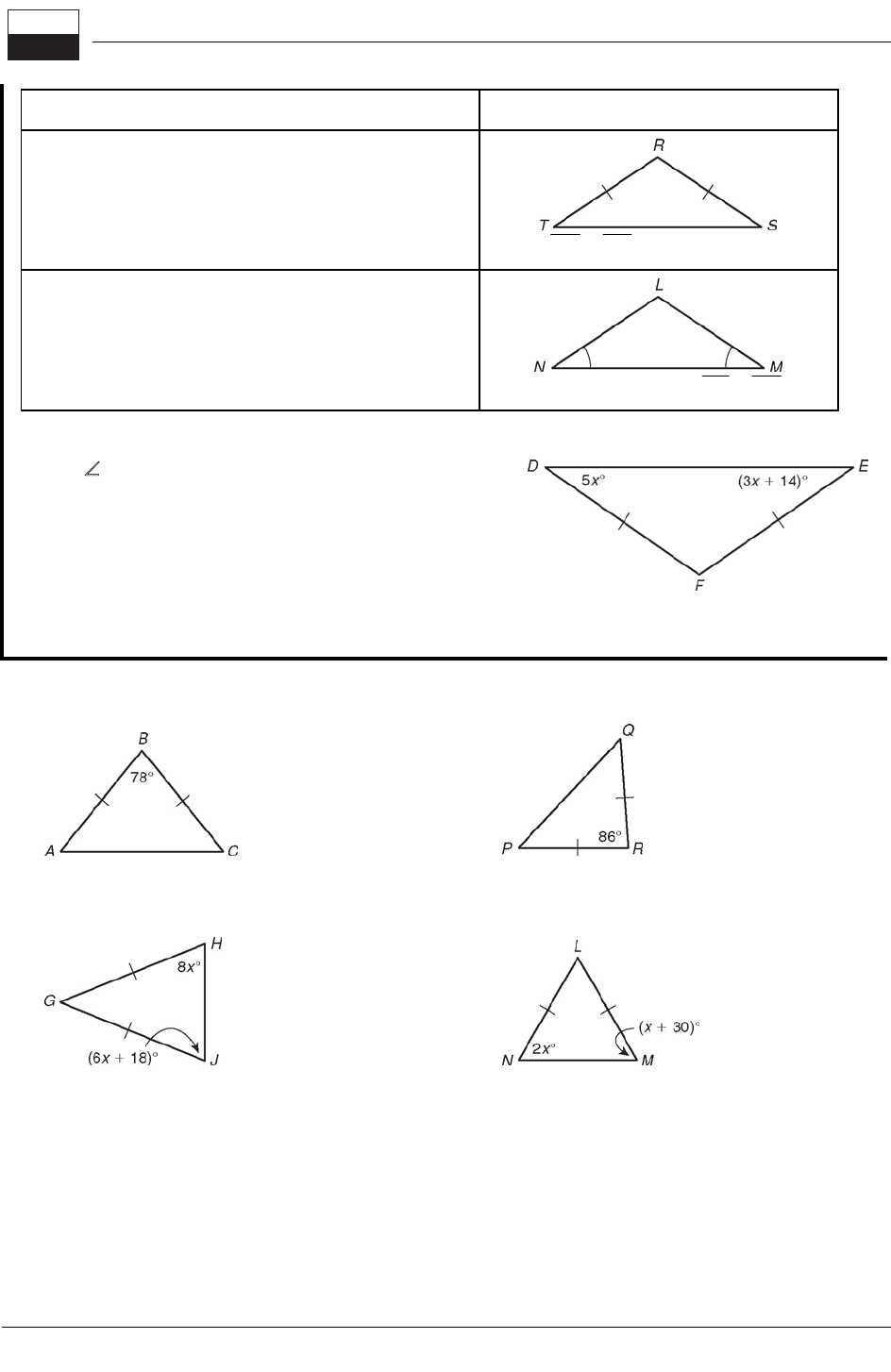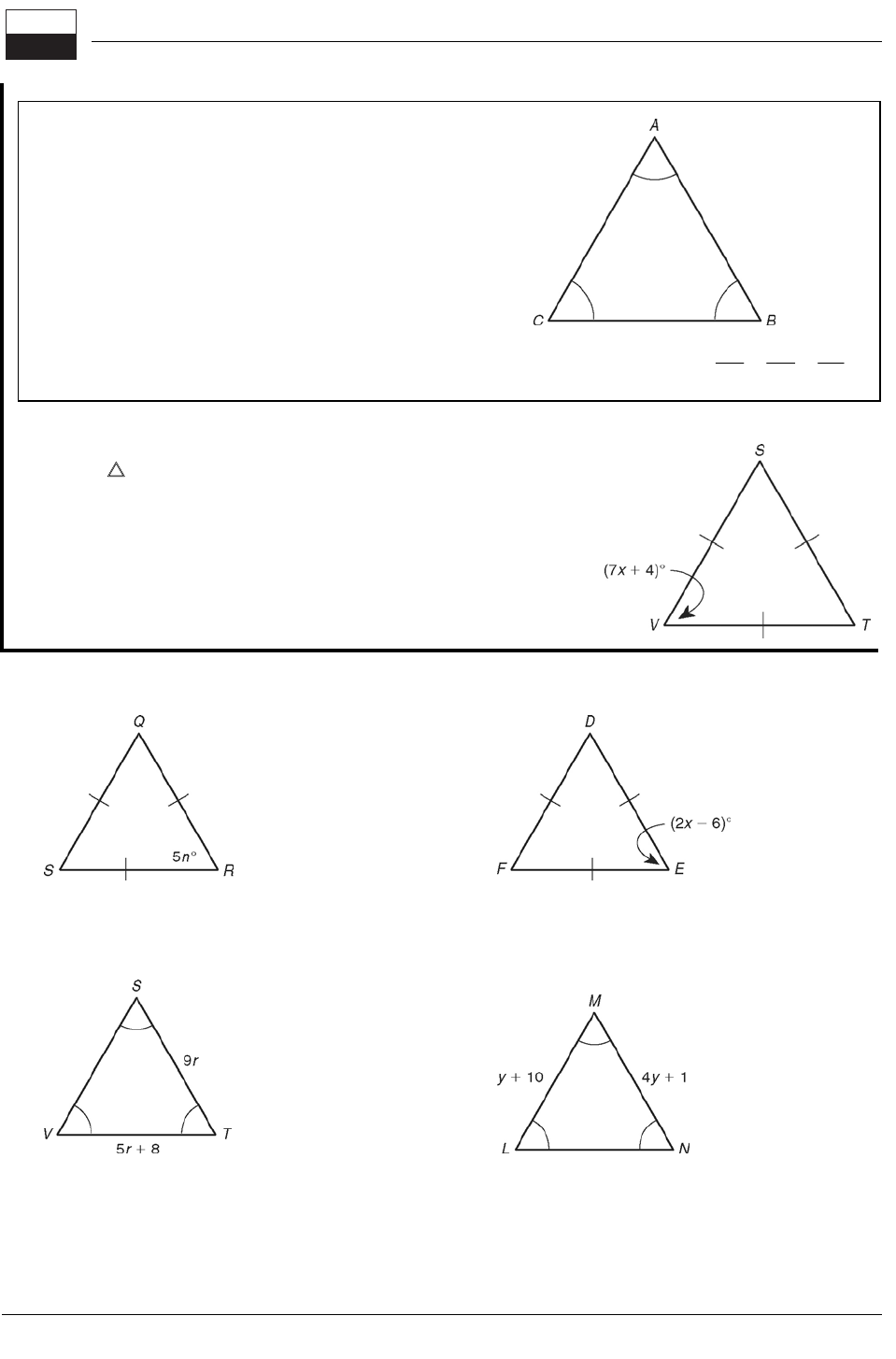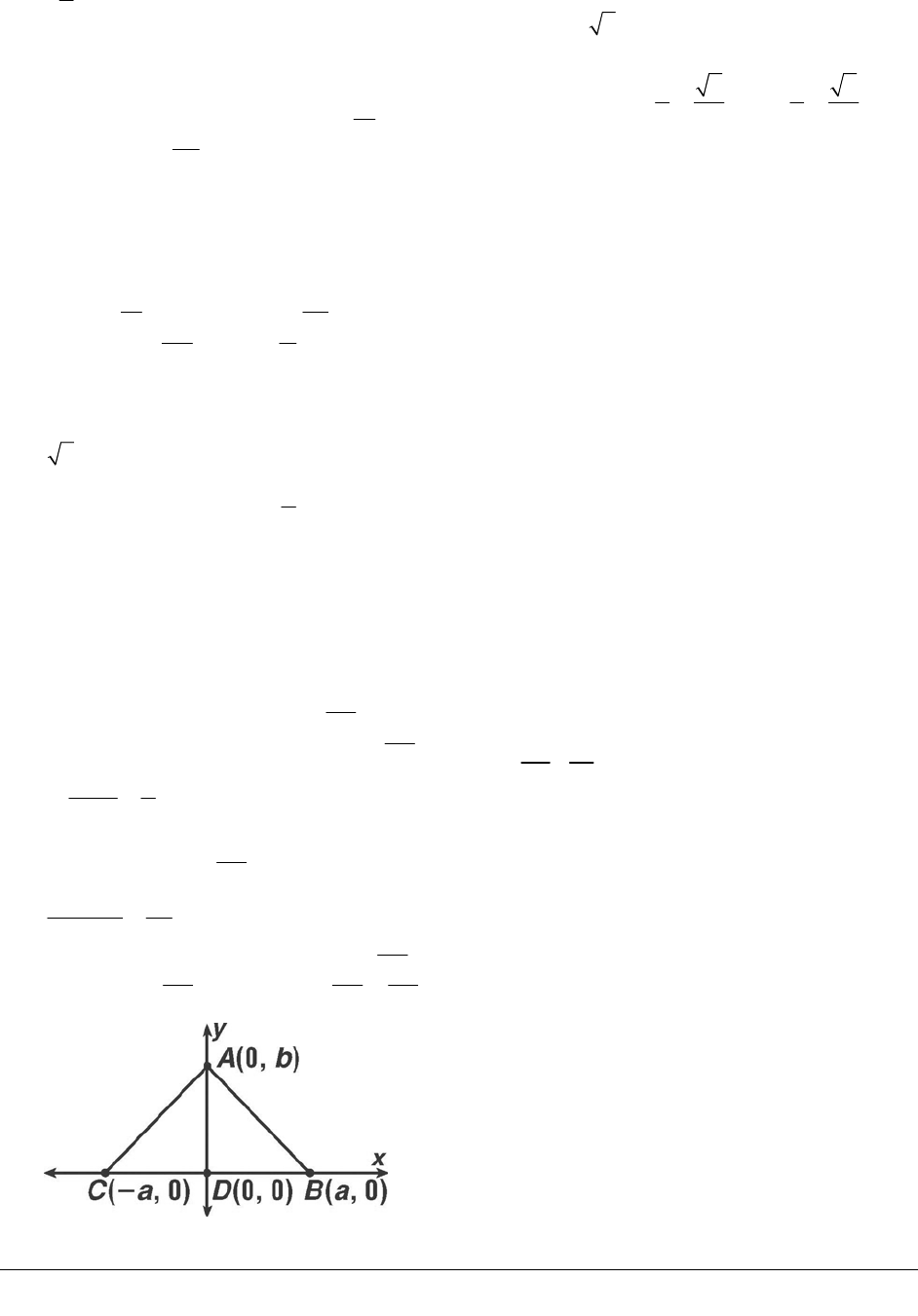
Name ________________________________________ Date __________________ Class__________________
Original content Copyright © by Holt McDougal. Additions and changes to the original content are the responsibility of the instructor.
Holt McDougal Geometry
Reteach
Isosceles and Equilateral Triangles
You can use these theorems to find angle measures in isosceles triangles.
Find m∠E in UDEF.
m∠D = m∠E Isosc. U Thm.
5x� = (3x + 14)� Substitute the given values.
2x = 14 Subtract 3x from both sides.
x = 7 Divide both sides by 2.
Thus m∠E = 3(7) + 14 = 35�.
Find each angle measure.
1. m∠C = _____________________ 2. m∠Q = _____________________
3. m∠H = _____________________ 4. m∠M = _____________________
Theorem Examples
Isosceles Triangle Theorem
If two sides of a triangle are congruent, then the
angles opposite the sides are congruent.
If
,RT RS≅ then �T � �S.
Converse of Isosceles Triangle Theorem
If two angles of a triangle are congruent, then
the sides opposite those angles are congruent.
If
�N � �M, then .LN LM≅
Name ________________________________________ Date __________________ Class__________________
Original content Copyright © by Holt McDougal. Additions and changes to the original content are the responsibility of the instructor.
Holt McDougal Geometry
Reteach
Isosceles and Equilateral Triangles continued
You can use these theorems to find values in equilateral triangles.
Find x in USTV.
USTV is equiangular. Equilateral U → equiangular U
(7x
+ 4)� = 60° The measure of each ∠ of an
equiangular
U is 60°.
7
x = 56 Subtract 4 from both sides.
x = 8 Divide both sides by 7.
Find each value.
5. n = _____________________ 6. x = _____________________
7. VT = _____________________ 8. MN = _____________________
Equilateral Triangle Corollary
If a triangle is equilateral, then it is equiangular.
(equilateral
U → equiangular U)
Equiangular Triangle Corollary
If a triangle is equiangular, then it is equilateral.
(equiangular
U → equilateral U)
If �A � �B � �C, then AB BC CA≅≅.
4-70
LESSON
4-9
CS10_G_MECR710617_C04L09d.indd 70 4/8/11 10:27:56 AM

Name ________________________________________ Date __________________ Class__________________
Original content Copyright © by Holt McDougal. Additions and changes to the original content are the responsibility of the instructor.
Holt McDougal Geometry
Reteach
Isosceles and Equilateral Triangles
You can use these theorems to find angle measures in isosceles triangles.
Find m∠E in UDEF.
m
∠D = m∠E Isosc. U Thm.
5
x� = (3x + 14)� Substitute the given values.
2
x = 14 Subtract 3x from both sides.
x = 7 Divide both sides by 2.
Thus m
∠E = 3(7) + 14 = 35�.
Find each angle measure.
1. m∠C = _____________________ 2. m∠Q = _____________________
3. m∠H = _____________________ 4. m∠M = _____________________
Theorem Examples
Isosceles Triangle Theorem
If two sides of a triangle are congruent, then the
angles opposite the sides are congruent.
If ,
RT RS≅ then �T � �S.
Converse of Isosceles Triangle Theorem
If two angles of a triangle are congruent, then
the sides opposite those angles are congruent.
If
�N � �M, then .LN LM≅
Name ________________________________________ Date __________________ Class__________________
Original content Copyright © by Holt McDougal. Additions and changes to the original content are the responsibility of the instructor.
Holt McDougal Geometry
Reteach
Isosceles and Equilateral Triangles continued
You can use these theorems to find values in equilateral triangles.
Find x in USTV.
USTV is equiangular. Equilateral U → equiangular U
(7x + 4)� = 60° The measure of each ∠ of an
equiangular U is 60°.
7x = 56 Subtract 4 from both sides.
x = 8 Divide both sides by 7.
Find each value.
5. n = _____________________ 6. x = _____________________
7. VT = _____________________ 8. MN = _____________________
Equilateral Triangle Corollary
If a triangle is equilateral, then it is equiangular.
(equilateral
U → equiangular U)
Equiangular Triangle Corollary
If a triangle is equiangular, then it is equilateral.
(equiangular
U → equilateral U)
If �A � �B � �C, then AB BC CA≅≅.
4-71
LESSON
4-9
CS10_G_MECR710617_C04L09d.indd 71 4/8/11 10:27:56 AM

Original content Copyright © by Holt McDougal. Additions and changes to the original content are the responsibility of the instructor.
Holt McDougal Geometry
9. 693 ft 10. 50°
11. 6.3 12. 60°
13. 4
1
2
yd 14. 65
°
15. 8
Practice B
1. Possible answer: It is given that HI is
congruent to
HJ , so ∠I must be
congruent to
∠J by the Isosceles Triangle
Theorem.
∠IKH and ∠JKH are both right
angles by the definition of perpendicular
lines, and all right angles are congruent.
Thus by AAS,
UHKI is congruent to
UHKJ. IK is congruent to KJ by
CPCTC, so
HK bisects IJ by the
definition of segment bisector.
2. 58.1 ft
3. 45°
4. 2 5. 36 or 9
6. 76° 7.
4
3
8. 10
9. 30°
10. 89
Practice C
1. Possible answer: UABC is an isosceles
triangle with vertices
A(0, b), B(a, 0), and
C(−a, 0). D is the midpoint of BC , so D
has coordinates (0,0). The slope of
AD
is
0
00 0
bb−
=
−
, so the slope is undefined. A
line with an undefined slope is a vertical
line. The slope of
BC is
00 0
0
()2
aa a
−
==
−−
. A line with a zero
slope is a horizontal line. Because
AD is
vertical and
BC is horizontal, AD BC⊥ .
2.
x = 36; y = 72; z = 36
3. 2
A
4. Possible answer: The coordinates of
Y
are (
a, 3a ). The Midpoint Formula
shows that the midpoints of the sides of
UXYZ are
13 33
,,,
22 22
AaaBaa
⎛ ⎞⎛ ⎞
⎜ ⎟⎜ ⎟
⎜ ⎟⎜ ⎟
⎝ ⎠⎝ ⎠
,
and C(a, 0). The Distance Formula gives
these distances: AX
= AY = AC = AB =
BC
= XC = BY = BZ = CZ = a. Thus by
SSS,
UABC ≅ UXAC ≅ UYAB ≅ UCBZ,
and the triangles are equilateral.
Reteach
1. 51° 2. 47°
3. 72° 4. 60°
5. 12
6. 33
7. 18 8. 13
Challenge
1. x = 10; By Isosc. U Thm. and U Sum
Thm., m
∠TSV = 54°. UQSV ≅ UTSV by
SSS, so m
∠VSQ = 54° by CPCTC.
m
∠QSR = 72° by Lin. Pair Thm. and by
∠ Add. Post. By Isosc. U Thm. and U
Sum Thm., m
∠SQR = 36°. Solve
(3x
+ 6)° = 36°. x = 10
2. 42.2;
UFJH is an equilat. U, so HJ = JF
= FH = 15 and x = 3. So GJ = 12.2.
FG FJ≅ since the sides opp. the
s
∠ are
≅. So FG = FJ = 15. UEFH ≅ UGFJ by
AAS, so the corr. sides are
≅ by CPCTC.
P
= 12.2 + 15 + 15 = 42.2
3. 108°;
UFJH is equiangular, so m∠JFH =
m
∠FJH = 60°. By Lin. Pair Thm. and ∠
Add. Post., m
∠FJG = 66°. By Isosc. U
Thm. and
U Sum Thm., m∠GFJ = 48°.
m
∠GFH = 48° + 60° = 108°
Problem Solving
1. 14 in. 2. 40°
3. 11 ft; m
∠GJH = 72° − 36° = 36°. m∠GHJ
= 36° by Alt. Int.
s
∠ Thm. By Converse of
Isosceles Triangle Theorem, GJ
= GH =
11 ft.
Original content Copyright © by Holt McDougal. Additions and changes to the original content are the responsibility of the instructor.
Holt McDougal Geometry
4. D 5. G
6. C 7. H
Reading Strategies
1. JI 12; If a triangle is equiangular, then it is
equilateral.
2. m
∠A 60°; If a triangle is equilateral, then
it is equiangular.
3. m
∠Z 45°; If two sides of a triangle are
congruent, then the angles opposite
those sides are congruent.
4. QR 10; If two angles of a triangle are
congruent, then the sides opposite those
angles are congruent.
A46
CS10_G_MECR710617_C04_AK.indd 46 4/14/11 2:48:51 PM
